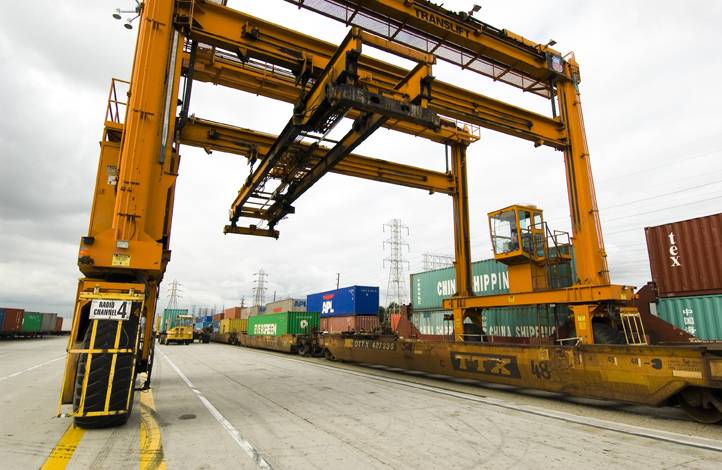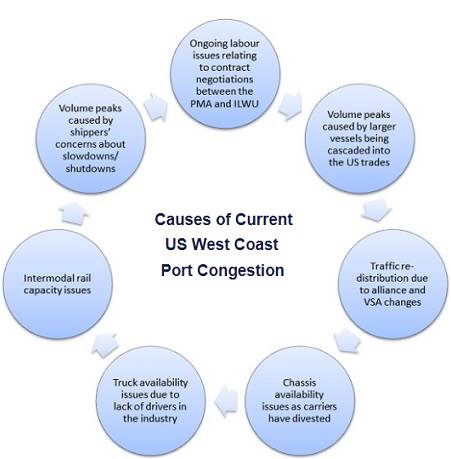Ports on the U.S. West Coast are currently suffering from chronic congestion, but are there deeper issues affecting their performance?
Drewry’s new report Container Terminal Capacity and Performance Benchmarks compares capacity and performance benchmarks for 500 terminals worldwide that help to explain some of the underlying factors hindering ports in North America.
The severe congestion currently affecting U.S. West Coast ports is a consequence of a “perfect storm” of factors working together, Drewry said.
The situation has now deteriorated to the point of mud-slinging between the employers (PMA) and the union (ILWU). Major carriers have had enough and are imposing congestion surcharges of up to $1,000 per feu for cargo moving through U.S. West Coast ports.
The troubles have prompted cargo owners and forwarders to write to President Obama suggesting that “a full shutdown of every west coast port may be imminent”, seeking federal mediation and if necessary the invoking of the Taft-Hartley Act in the event of a total closure. The Act would force labor back to work and was last used in the ports by President George W. Bush in 2002 after a 10-day shutdown.
The stakes are high. The U.S. West Coast lockout 12 years ago cost the U.S. economy an estimated $1 billion a day and it took six months for the ports to clear the backlog. A recent study commissioned by the National Association of Manufacturers and the National Retail Federation estimated the potential cost to the US economy of a west coast port shutdown has more than doubled since 2002 to as much as $2.5 billion per day if it were to last 20 days.
Clearly at some stage, one way or another, the congestion will ease as steps are taken to address the issues, and US ports will return to “normal”. However, this norm is still one that sees North American terminals under-perform the rest of the world in terms of the intensity of the use of the three key assets of container terminals – the quay line, gantry cranes and terminal land area.
Drewry’s new report, Container Terminal Capacity and Performance Benchmarks, assesses the actual performance of a sample of around 500 major terminals worldwide. The analyses are deliberately distinct from typical service level related measures such as crane moves per hour. Instead, they reflect the performance of the most important – and expensive – infrastructure and equipment assets in a modern container terminal.
The average performance of North American terminals is well below both the world average and the best performing region average for all three metrics.
There are very significant reasons for the current congestion in U.S. ports, but underlying this it is clear that North American terminals do not make as intensive use of their infrastructure and equipment as elsewhere. If U.S. terminals could improve this position, then it would help to avoid or defer the onset of any future congestion problems.
So why is the performance of North American terminals below the world average? There are a number of reasons, some of which are endemic, others which can be addressed over time.
Traffic type
The Drewry report shows that terminals with a significant proportion of transhipment perform better than those focused more on gateway traffic. U.S. terminals handle very little transhipment (a reflection of the relatively high handling costs in the U.S., themselves a consequence of high labor costs). In addition, the gateway traffic handled by U.S. terminals is mainly imports, and import traffic tends to have longer dwell times in the yard than exports, and more complicated handling requirements. It seems unlikely that U.S. terminals will markedly change their traffic mix in the foreseeable future, so this factor has to be regarded as immovable.
Terminal size
The typical terminal size in the U.S. is around 25% smaller than the world average, and the Drewry research clearly shows that bigger terminals perform better than smaller ones in terms of intensity of asset use. Fragmentation of terminal capacity is therefore a very significant issue, especially on the U.S. West Coast.
Activity is spread across a number of smaller terminals rather than being concentrated in a few large ones, as is the case for example in large European ports like Rotterdam, Bremerhaven and Hamburg. This is an area where the U.S. ports can and in some cases already are seeking to take action and physically consolidate terminals through construction/reconstruction.
Working hours
The below average performance of North American ports is also a reflection of working hours. Elsewhere in the world, un-interrupted 24/7 working is more common, sometimes across all aspects of a terminal (landside and well as shipside), whereas in the U.S. in particular, factors such as labor agreements and costs restrict the feasibility of this.
In this respect, terminal automation would help, as automated machines have no aversion to working unsociable hours and without breaks. Automation is something which is now picking up pace in the U.S. after a long hiatus since it was first introduced at the former APM Terminals facility in Virginia way back in 2007. However, it remains to be seen how effective the employers and unions are prepared to allow automation to be in practice.
According to Drewry, North American, and in particular U.S. container terminals, need to take steps to improve the intensity of infrastructure and equipment usage. This will require substantial investment and the cooperation of employers and the unions. The alternative is potentially huge macro-economic costs of further port congestion in future years.




















